Lighthouse Spirit of Pensacola: A Haunting Legend of Loss and Redemption
Reading Time: 15 min
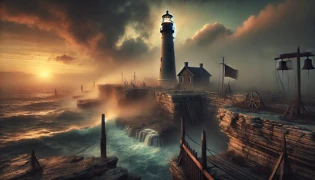
About Story: Lighthouse Spirit of Pensacola: A Haunting Legend of Loss and Redemption is a Legend from united-states set in the 20th Century. This Descriptive tale explores themes of Loss and is suitable for Adults. It offers Cultural insights. A ghostly guardian, former keepers’ legacy, and an emotional journey at Pensacola’s historic lighthouse.
Introduction
Perched on the edge of a rugged Pensacola coastline, the old lighthouse stood as both an emblem of hope and a relic of sorrow. Its beacon, once a guiding light for sailors lost in tumultuous storms, had grown dim with the weight of the decades. Locals spoke in hushed tones of a ghostly presence—a revered spirit who haunted its ancient walls. This was not merely a tale of the supernatural; it was a story of legacy, loss, and the undying desire for redemption that echoed through each creaking floorboard and whispering gust of coastal wind. The structure, battered by the relentless Atlantic winds and salt spray, held secrets of a time when a noble keeper tended the lamp with unwavering devotion. Now, in the fading amber glow of dusk, those secrets awakened once more. Former keepers, guardians of the lore, gathered in silent vigil, their eyes reflecting memories of both personal tragedy and profound love. They believed that the spirit was a bridge across time—a living embodiment of hopes unfulfilled, tragedies unresolved, and the enduring pulse of humanity clinging to the past. The lighthouse’s lonely cry into the dark expanse of the ocean was a lamentation as ancient as it was piercing, stirring the soul of every person who dared to listen. As the mist gently curled around the structure and the distant sound of crashing waves set a somber rhythm, the stage was set for a journey into the heart of mystery and emotion. It was here, amid swirling fog and the echoes of forgotten voices, that the past would meet the present, laying bare the stories of lives intertwined with the relentless sea and its eternal guardian.
The Haunting Light
Under a storm-darkened sky, the Pensacola Lighthouse loomed as a beacon of memories and mysteries. The narrative begins with an exploration of the lighthouse’s storied past that remains imprinted on its every stone and creaking door. Among those drawn to the lighthouse was Thomas Harding, a descendant of one of its most trusted keepers. His return to the place of childhood legends was driven by a paradoxical pull between fear and curiosity. Thomas remembered childhood nights when the lighthouse’s beam cut through swirling mists, and whispered stories of a keeper lost to a ferocious storm—a spirit who had forever imprinted his sorrows into that solemn edifice.
On an overcast evening, as heavy rain drummed the asphalt and waves smashed against the rocky shoreline, Thomas wandered the abandoned corridors. Dust danced in the puddles of weak light, and each step elicited both echoes and memories. In a quiet alcove of the aging structure, he found a faded journal—handwritten notes that spoke of hope, despair, and a promise to keep the light burning against the encroaching dark. The readings reminded him of the legacy of sacrifice carried by the former keepers, who had not only manned the lamp but also sheltered the ghosts of their own painful pasts.
Across town, whispers of similar phenomena stirred among the community. Amelia Raines, one of the former keepers and a figure as enigmatic as the lighthouse itself, had long since taken on the mantle of a silent guardian. Her gentle eyes concealed the grief of numerous lost nights spent listening for a shadow in the flickering glow. The ghost was described in local lore as gentle and somber, a spectral silhouette forever caught between earth and ocean, guiding those adrift in their own despair.
As the rain intensified, supernatural stirrings became undeniable. In one secluded chamber, Thomas felt a cold brush over his shoulder—a fleeting sensation that seemed to beckon him deeper into the heart of the mystery. The lighthouse, with its labyrinthine corridors and secret nooks, held more than just relics of the past; it breathed a living, psychic presence that stirred the soul. Here, the veil between the living and the dead felt almost tactile, as if the walls themselves were imbued with the sorrowful whispers of those long gone.
In a moment of profound stillness, the ancient lamp atop the tower flickered to life unexpectedly. The brilliant beam, though tempered by time, shone with an ethereal clarity that illuminated dust-laden portraits and relics of a bygone era. It was as if the very act of kindling the light summoned the spirit of the old keeper—a guardian who had once risked his life to guide weary sailors home, and who now watched over the lighthouse as a custodian of lost dreams. Thomas’s heart pounded in sync with the rhythmic crashing of the waves, and he realized that the haunting was not a malevolent force, but a profoundly human plea for remembrance and redemption.
The storm outside mirrored the tumult within him—a mix of fear, sorrow, and an inexplicable, magnetic hope. Every creak of the weathered wood and every softly murmured breeze carried echoes of a chapter in this sacred chronicle. As he continued his exploration, Thomas found himself piecing together his own narrative with that of the spectral guardian, understanding that the lighthouse’s mysterious luminescence was a call to honor the memories of those who had given everything to protect others from the merciless sea.
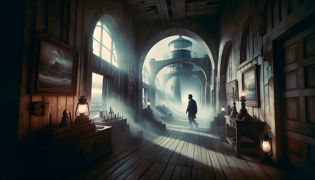
Echoes of the Past
Delving deeper into the heart of the lighthouse, the narrative shifts to the disquieting echoes from a past marred by tragedy and undying love. Amelia Raines, the resident guardian and former keeper, held within her a treasury of forgotten memories. Her life had been intertwined with the very essence of the lighthouse. She recalled nights when, amid the roaring winds and tempestuous seas, a young keeper named Jonathan—a man of unyielding courage and tender romance—had vowed to protect both the light and his beloved. His life was claimed by a sudden, merciless squall, leaving behind a shattered legacy and a spectral promise.
Through a series of bittersweet recollections, Amelia remembered the laughter of long-gone nights, when the sound of the lighthouse bell was a lullaby for the lonely. The halls of the vault were adorned with portraits and letter scraps, each a testament to moments of hope and despair. Jonathan’s image, captured in a sepia photograph, served as an eternal reminder of love lost to time. His final letter, filled with dreams of eternal reunion and a promise to return from the depths of the sea, was kept securely within the confines of the lighthouse. Over the years, Amelia had come to believe that Jonathan’s spirit lingered on, waiting for the day when the past and present might converge in a cathartic reunion.
As Amelia recounted her memories to a small, gathered group of old keepers and curious locals, her words painted a vivid tableau of a bygone era. The narrative wove together the gentle murmur of the waves with the soft hum of the wind chime left behind by Jonathan. In every whispered remembrance was a hidden plea for closure—a desire to mend broken promises from an age when every life was a sacrifice to the sea. The energy in the lighthouse grew palpable, as if the very bricks resonated with the fervor of old heartbreak and the undaunted strength of love. She described nights when the ghostly presence would make itself known in the corridor near the keeper’s quarters, its silhouette half-formed against the faint light of a dying lantern.
The memories were not merely personal reflections; they were tributaries feeding into the great river of the lighthouse’s legend. Each story was layered, building upon centuries of maritime lore and the sorrowful beauty of lives spent in service, love, and sacrifice. The emotional weight of these recollections transformed the lighthouse into a living museum—a sacred space where the past was never truly forgotten, and where every echo of the lost could be heard in the soft moan of the ocean wind.
One stormy evening, driven by a mix of longing and determination, Amelia revisited the keeper’s log. As she gently turned brittle pages filled with dust and handwritten secrets, she almost heard Jonathan’s soft voice in the rustling paper. The room, lit by a solitary candle, seemed to pulse with the energy of a hundred bygone souls. In that delicate interplay between memory and the present, the spectral echoes became a tangible force—a bridge linking hearts separated by time and calamity. The air was thick with anticipation, as if the lighthouse itself was on the verge of revealing its most cherished secrets. For those who listened, every creak, every sigh of the wind, was a verse in an ancient ballad—a ballad of love, loss, and the hope of reconciliation.
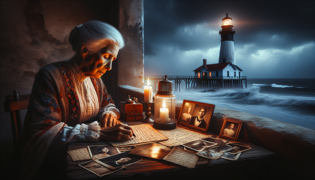
Guardians of the Beacon
In the present day, the lighthouse had become more than a relic of maritime history—it had evolved into a sanctuary where the living and the spectral coexisted in a delicate balance. Amid the turbulent backdrop of the modern world, a small group of former keepers and devoted caretakers had fashioned themselves as the guardians of the beacon. Leading them was Eleanor Morales, a resolute and empathetic figure whose connection to the lighthouse transcended generations. With her deep knowledge of its history and an almost mystical intuition about its secrets, Eleanor had dedicated her life to preserving the legacy of those who had perished under its light.
Eleanor’s leadership was defined by countless nights of tireless vigil, where she gathered the team to restore not only the physical structure but also the intangible spirit of the lighthouse. Under her guidance, the group embarked on painstaking restoration efforts. Every crack in the stone was filled with tender care, every rusted piece of maritime equipment lovingly restored. They organized community gatherings to celebrate the lighthouse’s legacy, inviting locals to share stories that had been passed down like treasured heirlooms. These evenings were charged with a sense of communion, as if the presence of the lost keepers was acknowledged through every shared memory and every gentle nod of respect.
Amid these efforts, a crisis loomed when a severe coastal storm threatened to demolish years of restoration work. The tempest, both literal and symbolic, tested the mettle of the guardians. As the wind howled and the sea raged with unbridled fury, Eleanor and her team braved the elements. In the midst of chaos, amid crashing waves and lashing rain, there were moments when the ghostly light atop the tower shone more brightly than ever before—almost as if offering a guiding hand. One night, as the storm reached its crescendo, Eleanor recalled a legend: that in the darkest hours, the spirit of the lighthouse would bestow a protective grace upon those who were true in heart.
Within the eye of the storm, as the crew struggled to secure fragile structural beams and prevent the collapse of the ancient lantern room, a sense of calm descended. It was as if the ghost of the former keeper had manifested, lending his timeless strength to bolster the team’s resolve. The battle against nature was not fought with sheer physical might alone but with a deep communion with the past. Every member of the guardian group felt an unspoken bond with those who had come before—a pledge that the light would never be extinguished, no matter the darkness.
In the hours that followed the storm, as dawn broke over a battered but still standing lighthouse, Eleanor documented the extraordinary events. The narrative of that night spread through whispers and local chronicles, rekindling a profound belief among the people that the lighthouse was watched over by benevolent forces beyond human ken. The struggle against nature, combined with the supernatural intervention, served to unite the community and reaffirm the sacred purpose of the beacon: to safeguard the memory of sacrifice, to be a light in both literal and metaphorical darkness, and to bind together a disparate community with the shared wattage of hope and reverence.
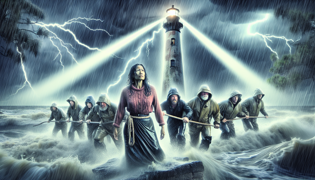
The Reunion of Souls
As the seasons changed and the scars of the storm began to heal, the inevitable climax of this long-held legend drew near. The spectral guardian, once a forlorn keeper bound by tragedy, seemed to grow stronger in the quiet intervals after the tempest. Thomas Harding, whose journey had begun with a search for his familial past, found himself once again drawn to the lighthouse—not merely as an observer, but as a catalyst for change. His dreams were haunted by images of a kind smile and a solemn promise that resonated deeply with the loss he had always carried. In these visions, he saw Jonathan, the fallen keeper whose life had been sacrificed to the merciless sea, reaching out from beyond time in a silent plea for reunion.
One crisp evening, under a sky strewn with countless stars and a gentle hush that belied the intensity simmering beneath the surface, destiny beckoned. A small ceremony was organized by Eleanor and the guardians—a moment of remembrance that invited the living to communicate with those long departed. Friends, family members, and local residents gathered around the base of the lighthouse. With a mix of reverence and hope, they lit candles and recited verses that had been passed down through generations. The air shimmered with anticipation, and it was as though the boundary between two worlds had begun to blur.
In the glow of a hundred flickering lights, Thomas stepped forward, holding the battered journal of his forebear. Every word, every tear-stained page echoed the legacy of love and sacrifice. Suddenly, the atmosphere shifted; the wind stilled, and the waves lapped gently at the shore. A luminous figure emerged at the very top of the tower—a spectral form that radiated a soft, otherworldly light. With every deliberate step, the figure descended, bathed in the harmonious glow of candlelight and starlight. The crowd watched in awed silence as the apparition, unmistakably Jonathan, reached the gathering. His eyes were filled not with sorrow but with an invitation to heal old wounds and to reconcile with relentlessly haunting memories.
In that transcendent moment, time itself seemed to fold. Words were unnecessary as tearful smiles and soft murmurs conveyed a thousand unspoken sentiments. The reunion was both a farewell to past grief and an embrace of the yearning for redemption. The spectral keeper, with a gentle nod, seemed to pass on a legacy of forgiveness—an affirmation that even in the heart of despair, there dwells a spark that can reunite fragmented souls. As the apparition faded into the night, its message remained indelibly imprinted on the hearts of all present. It was a reminder that love, though touched by loss, endures beyond the constraints of mortal life, and that the light of remembrance can guide even the most troubled souls toward peace and wholeness.
In the days that followed, the lighthouse continued to stand as a silent testament to the power of memory and reconciliation. The story of that ethereal reunion rippled through the community, inspiring art, literature, and renewed commitments to preserving the lighthouse’s legacy. The ghosts of the past were no longer feared; instead, they were celebrated as custodians of lessons that transcended time, binding generations with an unbreakable, luminous thread.
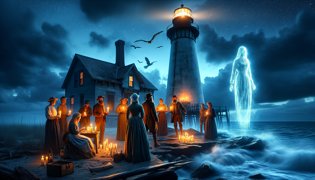
Conclusion
In the gentle afterglow of that unforgettable night, the Pensacola Lighthouse stood as a beacon of both remembrance and rebirth. The spectral guardian’s visit had woven together the disparate threads of history, loss, and longing into a tapestry of hope and renewal. Thomas Harding, long haunted by the shadows of his ancestry, found solace in the realization that every tear shed in sorrow had nourished the seeds of redemption. His journey had evolved from a solitary quest for answers into an embrace of the collective legacy that bound him to both the living and those who had passed on.
Eleanor Morales, ever the stalwart protector of the lighthouse’s tradition, viewed the reunion as a culmination of years of devotion and hard-fought preservation. The tempest that had once threatened to erase the memories of the past had instead cleansed the soul of the community, leaving behind a resilient spirit that would guide generations to come. The once dissonant echoes within the crumbling walls now harmonized with the soft murmur of the ocean—a lullaby of forgiveness and continuity. Neighbors, friends, and family gathered to celebrate not only a reunion of souls but the eternal flame of human connection that transcended the boundaries of time and mortality.
As the days turned into months, the lighthouse transformed into a living monument—a place where stories were shared, and old wounds healed. Visitors from far and wide came seeking solace or inspiration, and with each new tale, the legacy grew richer. The ghostly guardian was no longer seen as an omen of sorrow, but as a reminder of the profound truth that in every ending there is the promise of a new beginning. The light burned on, unwavering and eternal, a silent promise to all who dared to dream that love, loss, and redemption were intricately intertwined in the human experience.
In the end, the Pensacola Lighthouse was more than a structure against the relentless tide; it was a sanctuary of memories, a beacon to guide lost souls back to the shores of hope. And as the gentle light met the endless horizon, it whispered a quiet vow: that the legacy of the past would forever shine, illuminating the darkness and inviting all to witness the transformation of sorrow into everlasting grace.
















